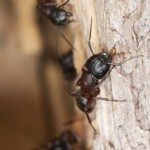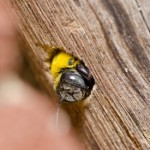“Home inspections.. with absolute character and integrity.”
Wood Destroying insects and organisms
While not common, we do come across termites in Chicagoland. More often we find evidence of carpenter ants, Carpenter bees, powder post beetles and and some fungi that can damage wood.

Subterranean Termites
Termites:
Termites eat wood and convert wood fiber, or cellulose, into sugar. A large termite colony can do extensive damage to structures made of wood. Since termites often consume wood from the inside out internally damaged wood can appear perfectly normal. There are many different types of termites but most occur in warm tropical, semi-tropical, or hot, arid (desert) climates. Subterranean termites live in underground colonies and feed on buried wood. When the initial wood supply is depleted the colony may be extended through “shelter tubes” to above ground wood. This is when damage to structures is done.

Carpenter Ant
Carpenter Ants:
Carpenter ants nest in moist wood including rotting trees, tree roots, tree stumps, and logs or boards lying on or buried in the ground. They can also nest in moist or decayed wood inside buildings. Wood decay may be caused by exposure to leaks, condensation, or poor air circulation. Nests have been found behind bathroom tiles; around tubs, sinks, showers, and dishwashers; under roofing, in attic beams, and under subfloor insulation; and in hollow spaces such as doors, curtain rods, and wall voids. Carpenter ants may also nest in foam insulation. Carpenter ants feed on sources of protein and sugar. Outdoors, carpenter ants feed on living and dead insects. They are also very attracted to honeydew, a sweet liquid produced by aphids and scale insects. Aphids and scales feed on trees, shrubs, and other plants. Indoors, carpenter ants feed on meats, as well as syrup, honey, sugar, jelly, and other sweets. Carpenter ants DO NOT eat wood. They remove wood as they create galleries and tunnels. Most foraging is done at night between sunset and midnight during spring and summer months. Sometimes workers travel up to 100 yards from a nest in search of food.

Carpenter Bee
Carpenter Bees:
Carpenter bees resemble bumble bees, but the upper surface of their abdomen is bare and shiny black; bumble bees have a hairy abdomen with at least some yellow markings. Despite their similar appearance, the nesting habits of the two types of bees are quite different. Bumble bees usually nest in the ground whereas carpenter bees tunnel into wood to lay their eggs. Bare, unpainted or weathered softwoods are preferred, especially redwood, cedar, cypress and pine. Painted or pressure-treated wood is much less susceptible to attack. Common nesting sites include eaves, window trim, facia boards, siding, wooden shakes, decks and outdoor furniture.
Carpenter bees overwinter as adults in wood within abandoned nest tunnels. They emerge in the spring, usually in April or May. After mating, the fertilized females excavate tunnels in wood and lay their eggs within a series of small cells. The cells are provisioned with a ball of pollen on which the larvae feed, emerging as adults in late summer. The entrance hole and tunnels are perfectly round and about the diameter of your finger. Coarse sawdust the color of fresh cut wood will often be present beneath the entry hole, and burrowing sounds may be heard from within the wood. Female carpenter bees may excavate new tunnels for egglaying, or enlarge and reuse old ones. The extent of damage to wood which has been utilized for nesting year after year may be considerable.
Powderpost Beetles:
Powderpost beetles include several small, brownish, dry wood-eating insects ranging in size from one-twelfth to one-fifth inch long. Three families, Lyctidae, Anobiidae, and Bostrichidae, are most common in Michigan.
Powderpost beetles were so named because the wood upon which they feed is generally eaten into a fine, flourlike powder. The Lyctus types feed primarily on hardwoods; the Anobiids prefer to attack softwoods, such as conifers. They can damage and, in some cases, eventually destroy (by completely tunneling) all exposed wood in houses, including furniture and paneling. Severe damage may take many years to materialize. A case of this kind usually results from failure to apply early remedies. Watch for “shot holes” in the wood.
The Lyctus powderpost beetles are usually brought into buildings in lumber which has been stored in yards or at building sites. They may also be present in furniture, wood paneling, and firewood. Damage is usually to the starch-rich sapwood of large-pored hardwoods such as ash, hickory, oak, walnut and cherry. The hardwood floors of new homes are commonly attacked.
You can easily recognize the work of powderpost beetles. When the adults emerge, usually in June, some species leave small holes about the size of a pin in the surface of the wood; others make holes the size of pencil lead. From these holes, a fine, powderlike brood of larvae carry on their destructive feeding. Normally, these insects have a 1-year life cycle; this means that the adults will appear only once each year. And because of this habit the larvae have a feeding period of many months.
The Do’s and Don’ts of pest control
Do safely and correctly use pesticides.
Keep pets and children away from areas where pesticides have been applied.
After preventative steps have been taken, you can use baits as a first line of chemical defense against insects or rodents. These are often effective and can be used with low risk of exposure to the pesticide, as long as they are kept out of the reach of children and pets.
Other relatively low-risk pesticides are available for some pests. Consult your local cooperative extension service office for recommendations suitable for your area. The U.S. Department of Agriculture’s Web site can help you identify your local extension service office.
Pesticides not contained in baits or traps should generally only be applied to targeted locations, not sprayed over the whole room. Use fogging devices only when absolutely necessary.
Always read and follow the pesticide label’s instructions and safety warnings.
Use ready-to-use products (i.e., no mixing needed) whenever possible.
If you hire any outside persons to help control pests, ask them to find and correct the source of the problem before applying pesticides. For example, you might have to repair a leaky toilet to remove a water source. Ask them to use baits and crack and crevice treatments when feasible.
Only apply chemicals approved for use in homes; the label will list where the chemical may be used; write down the name and EPA registration number of any chemical used by someone you hire. You will need this information if you decide to look up more information on the pesticide. The pest control operator should be able to provide information about the chemical, such as the material safety data sheet.
Do dispose of leftover pesticides and pesticide containers properly.
Read the label to find out how to dispose of the pesticide and the container.
Many communities have household hazardous waste collections that will accept unwanted pesticides. Call your waste disposal authority for information about your community.
Don’t use outdoor chemicals indoors.
Many chemicals intended for use outdoors are dangerous to use indoors because they will remain toxic longer inside than they would outdoors.
Don’t assume that twice as much is better.
Always read and follow label directions.
Using too much of a pesticide can endanger your family’s health.
Don’t transfer pesticides to other containers.
Store pesticides in their original containers.
Only mix as much as you are going to use at one time if the pesticide must be mixed with water.
Children and others have been poisoned by accidentally consuming pesticides stored in food or beverage containers. Don’t use empty pesticide containers to store anything else.
No matter how well you wash the container, it could still contain remnants of the pesticide and could harm someone.
